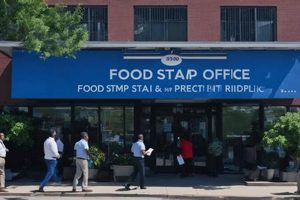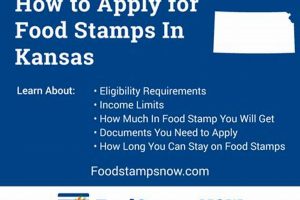Supplemental Nutrition Assistance Program (SNAP) benefits, often referred to as food stamps, are available to eligible individuals and families to combat food insecurity. Eligibility is primarily based on income and resources; however, specific rules apply, and these rules can vary by state. For individuals experiencing homelessness, access to these benefits can be a crucial lifeline in obtaining nutritious food.
The importance of nutritional assistance for the homeless population is significant. It alleviates hunger, promotes better health outcomes, and can serve as a stepping stone towards stability. Historically, barriers existed for this demographic, including address requirements and difficulties in providing necessary documentation. Recent policy changes and outreach efforts have aimed to mitigate these challenges and improve access. Many states are working to remove barriers in order to help this vulnerable population.
The following sections will delve into the specific eligibility criteria for homeless individuals, the application process, common challenges encountered, and the role of advocacy groups in ensuring access to these vital resources. The ultimate goal is to provide clarity on how individuals experiencing homelessness can navigate the system and receive the food assistance to which they are entitled.
Guidance on Accessing Food Assistance for Individuals Experiencing Homelessness
Navigating the application process for Supplemental Nutrition Assistance Program (SNAP) benefits, particularly for those without stable housing, can be complex. The following tips offer guidance to facilitate access.
Tip 1: Understand State-Specific Regulations: Eligibility criteria and application procedures for SNAP vary by state. Research the specific requirements in the state where assistance is sought. State websites and local social service agencies provide detailed information.
Tip 2: Utilize the Categorical Eligibility Exception: Many states have provisions that allow individuals receiving certain other public assistance benefits, such as General Assistance, to automatically qualify for SNAP, even if their income exceeds the standard limit. Explore if this applies.
Tip 3: Overcome Address Requirements: Lacking a permanent address can be a barrier. Many states allow individuals to use the address of a shelter, a soup kitchen, or a trusted service provider for mail delivery and application purposes. Confirm the acceptance of alternative addresses with the local SNAP office.
Tip 4: Gather Required Documentation: Although obtaining documentation can be challenging, efforts should be made to provide proof of identity and income (if any). Acceptable forms of identification may include a driver’s license, a birth certificate, or a statement from a social service agency. A sworn statement can sometimes substitute for missing documentation of income.
Tip 5: Seek Assistance from Local Organizations: Non-profit organizations, homeless shelters, and social service agencies often have staff or volunteers who can assist with the application process. These individuals can provide guidance, help gather documentation, and advocate on behalf of the applicant.
Tip 6: Be Prepared for the Interview: After submitting the application, an interview is typically required. Be prepared to answer questions about living situation, income, and expenses. Honesty and clarity are crucial during this process.
Tip 7: Understand Appeal Rights: If the application is denied, the applicant has the right to appeal the decision. The denial letter will outline the appeals process and deadlines. Seeking assistance from legal aid organizations can be beneficial during an appeal.
Successful navigation of the food assistance system for homeless individuals requires a thorough understanding of state regulations, proactive engagement with local resources, and persistence in overcoming potential barriers. Access to these benefits can significantly improve food security and overall well-being.
The subsequent sections will explore common misconceptions surrounding food assistance programs and strategies for continued advocacy to ensure equitable access for all individuals experiencing homelessness.
1. Eligibility Requirements
The ability of individuals experiencing homelessness to receive Supplemental Nutrition Assistance Program (SNAP) benefits, or food stamps, is directly contingent upon meeting specific eligibility requirements. These requirements, established at both the federal and state levels, dictate who qualifies for assistance. Failure to meet even one criterion can result in denial, underscoring the profound impact of these regulations. For example, while federal guidelines set broad parameters, individual states implement their own interpretations, potentially creating disparities in access. States may differ in how they treat income, assets, and residency requirements, which directly affects the number of homeless individuals deemed eligible.
A significant challenge arises from the documentary burden often associated with proving eligibility. Homeless individuals may lack traditional forms of identification, proof of income, or a permanent address. Many states have attempted to address this by allowing the use of shelter addresses or accepting alternative forms of verification from social service agencies. However, the process remains complex and can be a deterrent. Furthermore, income thresholds, even when nominally low, can exclude those with meager earnings from part-time work or temporary assistance. Resources, though often minimal for this population, are also factored into eligibility determinations, further complicating the assessment.
In conclusion, eligibility requirements represent a critical gateway to nutritional assistance for the homeless population. While programs exist to mitigate some barriers, such as address requirements, the complexity of the system and the stringent application of eligibility criteria continue to pose significant challenges. A thorough understanding of these requirements, coupled with advocacy for more flexible and compassionate policies, is essential to ensuring that those experiencing homelessness have access to this vital safety net.
2. Address Verification
Address verification presents a significant hurdle for individuals experiencing homelessness attempting to access Supplemental Nutrition Assistance Program (SNAP) benefits. The requirement to provide a verifiable address is a standard component of the SNAP application process, yet it inherently disadvantages those without stable housing.
- Traditional Address Requirements
Historically, SNAP applications required a physical residential address for mail delivery and to establish residency within a specific jurisdiction. This requirement effectively excluded individuals living on the streets, in shelters lacking mail services, or in temporary accommodations. The inability to provide such an address led to automatic denial of benefits, irrespective of other qualifying factors like income or need.
- Alternative Address Options
To address this barrier, many states have implemented policies allowing the use of alternative addresses. Common examples include permitting the use of a shelter’s address, the address of a social service agency, or a post office box. However, the acceptance of these alternative addresses varies by state and sometimes by local SNAP office, creating inconsistency and requiring applicants to navigate complex regulations.
- Challenges with Alternative Addresses
Even with alternative address options available, practical challenges persist. Shelters may have limited capacity to handle large volumes of mail, increasing the risk of misdelivery or loss of important benefit-related documents. Additionally, requiring a connection to a specific service provider may limit an individual’s freedom to choose where they receive assistance, potentially impacting their access to other needed resources.
- Impact on Benefit Access
The stringent application of address verification policies can create a significant barrier to entry for SNAP benefits. Individuals without a stable address may face delays in processing their applications, be required to make repeated visits to social service agencies, or ultimately be denied benefits altogether. This directly undermines the program’s aim of providing nutritional assistance to those most in need, particularly among the homeless population.
The connection between address verification and accessing food stamps is thus critical for homeless individuals. While efforts have been made to accommodate those without permanent housing, ongoing policy adjustments and increased awareness among caseworkers are necessary to ensure equitable access to these vital resources.
3. Income Limits
Income limits serve as a primary determinant in Supplemental Nutrition Assistance Program (SNAP) eligibility, thereby directly impacting whether individuals experiencing homelessness can access food stamps. These limits, established at the federal level and often adjusted by states, dictate the maximum permissible income for a household to qualify for benefits. The stringency and application of these limits significantly influence the accessibility of food assistance for this vulnerable population.
- Gross Income vs. Net Income
SNAP considers both gross (total) and net (income after deductions) income when determining eligibility. While gross income must fall below a certain threshold, deductions for housing costs, medical expenses, and dependent care can lower the net income, potentially enabling qualification. For homeless individuals, limited access to housing and healthcare may hinder their ability to claim these deductions, thereby making it more difficult to meet net income requirements.
- Categorical Eligibility
Some states offer “categorical eligibility,” which allows individuals receiving certain other public assistance benefits (e.g., Temporary Assistance for Needy Families or Supplemental Security Income) to automatically qualify for SNAP, regardless of income. This provision can be particularly beneficial for homeless individuals who may have limited income but meet the criteria for other support programs. However, the availability and specific requirements for categorical eligibility vary widely by state, creating disparities in access.
- Earned vs. Unearned Income
SNAP distinguishes between earned income (wages from employment) and unearned income (benefits, pensions, etc.). Both types of income are considered when calculating eligibility. Homeless individuals often rely on sporadic or part-time employment, resulting in fluctuating earned income. The interaction between this earned income and any unearned income sources can create complex eligibility scenarios, potentially leading to periods of ineligibility or reduced benefits.
- Impact of In-Kind Income
In-kind income, such as free meals provided by shelters or soup kitchens, is generally not counted as income for SNAP purposes. This provision acknowledges the reliance of homeless individuals on charitable food assistance. However, inconsistent interpretation of what constitutes in-kind income can create challenges. For example, if a shelter provides a small stipend alongside meals, this stipend may be considered income, potentially affecting SNAP eligibility.
Income limits represent a critical factor in determining access to food stamps for the homeless. While provisions exist to accommodate some of the unique circumstances faced by this population, the complexity of the regulations and the variable application across states can create significant barriers. Advocacy efforts focused on simplifying eligibility requirements and increasing awareness of available deductions are essential to ensuring that income limits do not disproportionately exclude homeless individuals from receiving vital nutritional assistance.
4. Application Process
The application process for Supplemental Nutrition Assistance Program (SNAP) benefits represents a crucial gateway for individuals experiencing homelessness seeking access to food stamps. Its design and implementation significantly affect whether this vulnerable population can effectively obtain needed nutritional assistance.
- Complexity of Forms and Documentation
SNAP applications often involve lengthy forms requiring detailed information about income, expenses, and household composition. Homeless individuals may face challenges in completing these forms due to literacy barriers, lack of access to documentation, or difficulty recalling specific details. The complexity of the forms can be a significant deterrent, leading to incomplete or abandoned applications.
- Interview Requirements and Scheduling
A SNAP interview is typically required as part of the application process. Scheduling and attending these interviews can be particularly difficult for individuals without stable housing. Lack of transportation, unpredictable living situations, and competing priorities (such as seeking shelter or employment) can make it challenging to adhere to scheduled appointments. Missed interviews can result in application delays or denials.
- Navigating Bureaucratic Procedures
The SNAP application process often involves navigating complex bureaucratic procedures and interacting with multiple agencies or caseworkers. Homeless individuals may lack familiarity with these systems, as well as the support networks to help them navigate the process effectively. Misunderstandings, communication barriers, and feelings of intimidation can further complicate the application journey.
- Wait Times and Processing Delays
The time required to process SNAP applications can vary, but lengthy wait times are not uncommon. For homeless individuals, these delays can exacerbate food insecurity and create immediate hardship. The lack of immediate access to benefits can undermine the program’s ability to provide timely nutritional assistance, particularly during periods of crisis or instability.
The various components of the application process, from initial form completion to final benefit approval, collectively determine the ease with which homeless individuals can access food stamps. Addressing the identified challenges through simplified procedures, targeted outreach, and enhanced support services is crucial for ensuring equitable access to this vital safety net.
5. Documentation Needs
The necessity of providing adequate documentation represents a significant obstacle for individuals experiencing homelessness seeking access to Supplemental Nutrition Assistance Program (SNAP) benefits. Lacking stable housing and often facing systemic barriers, obtaining the required paperwork presents a unique set of challenges that directly impact their ability to receive food stamps.
- Proof of Identity
Many SNAP applications require verifiable proof of identity. Homeless individuals may lack traditional forms of identification, such as driver’s licenses or birth certificates, often lost or stolen during periods of instability. While some states accept alternative forms of identification (e.g., statements from shelters or social service agencies), the process can be complex and inconsistent, potentially delaying or denying benefits.
- Verification of Income
Providing evidence of income is another common requirement. Homeless individuals who engage in sporadic or informal work may not have pay stubs or other traditional documentation to verify their earnings. Obtaining statements from employers or relying on self-attestation can be challenging, and inconsistent application of verification policies may create barriers to eligibility.
- Residency Verification
While many states have relaxed address requirements, providing some form of residency verification is often still necessary. Homeless individuals may rely on shelter addresses or letters from social service providers. However, the validity and acceptance of these alternative forms of residency verification can vary, and individuals may encounter difficulties in establishing a consistent and verifiable residential tie.
- Medical and Disability Documentation
Certain SNAP deductions and exemptions are available to individuals with medical expenses or disabilities. However, accessing the necessary medical records and documentation can be difficult for those without regular healthcare access. Obtaining diagnoses, treatment records, or disability determinations may require navigating complex healthcare systems and overcoming logistical challenges, further complicating the application process.
The multifaceted documentation needs associated with SNAP applications disproportionately affect homeless individuals, creating a significant impediment to accessing food stamps. While efforts have been made to accommodate those without traditional forms of documentation, the ongoing need for comprehensive, verifiable information continues to pose a major barrier to this vulnerable population. Streamlining documentation requirements and providing targeted assistance to help homeless individuals gather the necessary paperwork are crucial steps in ensuring equitable access to nutritional assistance.
6. State Variations
State variations significantly influence the ability of homeless individuals to access Supplemental Nutrition Assistance Program (SNAP) benefits. Federal guidelines provide the overarching framework, but individual states retain considerable latitude in implementation. This leads to a patchwork of eligibility criteria, application processes, and benefit levels that directly impacts the degree to which homeless populations receive food stamps.
One critical area of variation lies in categorical eligibility. Some states automatically qualify individuals receiving certain other forms of public assistance (such as General Assistance) for SNAP, regardless of income. This can be a lifeline for homeless individuals with limited or no income. Conversely, states without such categorical eligibility provisions may impose stricter income thresholds, excluding many homeless individuals from receiving benefits. For example, a state with generous categorical eligibility might see a higher percentage of its homeless population receiving SNAP compared to a state that relies solely on stringent income requirements.
Another important variation relates to the acceptance of alternative address verification methods. States that readily accept shelter addresses or letters from social service agencies as proof of residency significantly reduce a barrier to entry for homeless applicants. States with more restrictive address verification policies create additional hurdles. States also vary in their outreach efforts to the homeless population. Proactive states may partner with local organizations to conduct on-site SNAP application assistance at shelters and meal programs, while other states may rely solely on traditional application channels, which are less accessible to those without stable housing. The practical significance of understanding these state variations lies in advocating for policies that promote equitable access to SNAP for homeless individuals across all jurisdictions. It also underscores the importance of tailoring assistance strategies to the specific regulatory environment of each state.
7. Outreach Programs
Outreach programs play a pivotal role in connecting individuals experiencing homelessness with Supplemental Nutrition Assistance Program (SNAP) benefits. These programs serve as a bridge, actively seeking out and assisting a population that may face significant barriers to accessing available resources. The effectiveness and availability of such initiatives directly influence the extent to which homeless individuals receive food stamps.
- Direct Application Assistance
Many outreach programs provide hands-on assistance with the SNAP application process. This includes helping individuals complete forms, gather necessary documentation, and navigate the complex eligibility requirements. By directly addressing these procedural hurdles, outreach workers increase the likelihood that eligible homeless individuals will successfully apply for and receive food stamps. For example, mobile outreach teams may visit homeless encampments, offering on-site application assistance and reducing the need for individuals to travel to social service agencies.
- Information Dissemination and Education
Outreach programs play a critical role in informing homeless individuals about the availability of SNAP benefits and the eligibility criteria. This often involves distributing informational materials, conducting presentations at shelters and meal programs, and engaging in one-on-one conversations to address misconceptions or concerns. By raising awareness and providing accurate information, outreach programs empower individuals to make informed decisions about accessing food assistance.
- Liaison with Social Service Agencies
Outreach workers often serve as liaisons between homeless individuals and social service agencies responsible for administering SNAP. They may accompany individuals to application appointments, advocate on their behalf, and help resolve any issues or delays in processing. This support is particularly valuable for individuals who may feel intimidated by bureaucratic systems or lack the resources to navigate them effectively.
- Needs Assessment and Referral Services
Effective outreach programs conduct comprehensive needs assessments to identify the specific challenges and barriers faced by homeless individuals. In addition to SNAP assistance, they may provide referrals to other essential services, such as housing assistance, medical care, and mental health support. Addressing these underlying needs can indirectly improve access to food stamps by stabilizing individuals’ lives and increasing their capacity to navigate the application process.
In conclusion, the effectiveness of outreach programs is critical for ensuring that homeless individuals have access to SNAP benefits. These programs not only provide direct assistance with the application process but also play a vital role in disseminating information, advocating for individuals, and connecting them with other essential resources. The commitment of resources to robust and well-designed outreach programs is essential for maximizing the impact of SNAP in addressing food insecurity among the homeless population.
Frequently Asked Questions
This section addresses common inquiries regarding access to the Supplemental Nutrition Assistance Program (SNAP), often referred to as food stamps, for individuals experiencing homelessness. These questions aim to clarify eligibility, application processes, and potential challenges.
Question 1: Are individuals experiencing homelessness eligible for SNAP benefits?
Yes, homelessness does not automatically disqualify an individual from receiving SNAP benefits. Eligibility is primarily determined by income, resources, and adherence to state-specific regulations, irrespective of housing status.
Question 2: How can a homeless person provide an address for SNAP application purposes?
Many states permit the use of alternative addresses, such as a shelter, a soup kitchen, or a social service agency, for mail delivery and application processing. Applicants should verify acceptable address options with their local SNAP office.
Question 3: What documentation is required for a homeless individual to apply for SNAP?
Documentation requirements typically include proof of identity and verification of income (if any). States often accept alternative forms of identification, such as statements from social service agencies, in lieu of traditional documents.
Question 4: What if a homeless individual has no income; are they still eligible for SNAP?
Lack of income does not necessarily preclude eligibility. Even without income, an individual can apply and have their circumstances evaluated. States may have specific provisions for individuals with no income or minimal resources.
Question 5: Can a homeless individual receive SNAP benefits if they also receive meals from a shelter?
Yes, the receipt of free meals from shelters or soup kitchens generally does not impact SNAP eligibility. These meals are typically considered in-kind assistance and are not counted as income.
Question 6: What steps can be taken if a homeless individual’s SNAP application is denied?
Applicants have the right to appeal a denial. The denial letter will outline the appeals process and deadlines. Seeking assistance from legal aid organizations or social service agencies can be beneficial during the appeals process.
Accessing SNAP benefits is a crucial resource for combating food insecurity among the homeless population. Understanding eligibility requirements and overcoming potential barriers is essential for ensuring access to this vital safety net.
The following section will delve into resources and support services available to assist homeless individuals in accessing SNAP benefits.
Conclusion
The exploration of “do homeless people get food stamps” reveals a complex interplay of federal guidelines, state-specific regulations, and individual circumstances. While homelessness does not automatically disqualify an individual from receiving Supplemental Nutrition Assistance Program (SNAP) benefits, significant barriers exist. These include challenges in meeting documentation requirements, navigating complex application processes, and adhering to income limitations. State variations in eligibility criteria and the availability of outreach programs further contribute to disparities in access. Successful acquisition of these benefits requires a multifaceted approach, encompassing a thorough understanding of applicable rules, proactive engagement with support services, and persistent advocacy for policy changes that address the unique needs of this vulnerable population.
The provision of adequate nutritional assistance to individuals experiencing homelessness remains a critical imperative. Overcoming the systemic obstacles that impede access to SNAP is essential for promoting food security, improving health outcomes, and fostering pathways toward stability. Continued efforts to simplify application processes, expand outreach initiatives, and implement compassionate policies are vital to ensuring that all individuals, regardless of housing status, have the opportunity to meet their basic nutritional needs. The pursuit of equitable access to food assistance is not merely a programmatic goal but a fundamental commitment to human dignity.







